Trending
Opinion: How will Project 2025 impact game developers?
The Heritage Foundation's manifesto for the possible next administration could do great harm to many, including large portions of the game development community.
In this postmortem from Game Developer Magazine's March 2013 issue, get an insightful, behind-the-scenes look its design process.
October 25, 2024

[This postmortem for Telltale Games' The Walking Dead was originally published in the March 2013 issue of Game Developer Magazine. The original text has been restored in full, along with select visuals. To see the article in full, visit the .PDF at the GDC Vault archives.]
Telltale is a bit different from your typical game company. We bring some of the best stories from TV and film and make episodic “story” games from them. We do our own licensing, design, development, publishing, and marketing, all under the same roof. We also tend to make product decisions together as a studio. We are independent, but bigger than “indie.” All of this brings a very unique set of challenges with it, which makes this postmortem a bit different as well. At Telltale, working with external partners and figuring out what “playing a story” means is just as important as slinging DMA packets around and writing code that controls what each CPU core is doing.
We want to make games that let people immerse themselves within an actual role in stories like they never have before. We’ve had a fair bit of success in attracting some well-known licenses, but our roots are in graphic novels, reaching all the way back to Sam & Max and Bone. We were thrilled at the opportunity to tackle something as rich as The Walking Dead and work with Robert Kirkman. By now, our series has won more than 80 Game of the Year awards and has been widely recognized as a groundbreaking achievement in the industry, but it certainly wasn’t an overnight success!

Image via Game Developer Magazine, March 2013.
In early 2011 we reached out to The Walking Dead creator Robert Kirkman and his production company Skybound to discuss adapting his award-winning comics into a Telltale series. We were not going to pitch a game that was about killing zombies. Instead, we were going to pitch an episodic “story game” that focused on the thing we felt made his books so compelling: normal people adapting to impossible situations. The game we pitched was focused on dialogue and character development, and was to be incredibly cinematic and seriously emotional. We wanted people to connect with the characters and role-play like they never had before. There were certainly much more obvious takes on a zombie genre game, which made us a little nervous. Our pitch was probably not what they were expecting. Luckily, they were familiar with some of our previous work, so they took the meeting.
When we met with Robert and the other folks at Skybound, they were very impressed by our vision of what a Walking Dead game could be. They understood how such an approach, if successful, would capture a much deeper sense of what made the comics so successful. Most importantly, they saw a special opportunity and were willing to take this risk with us.
In the end, Robert Kirkman and everyone else at Skybound were (and are!) amazing partners. Even as the television show was becoming a runaway hit, they always made time to ensure we had the feedback and support we needed. One of the best things Robert did early on was introduce us to his friend Gary Whitta (screenwriter of Book of Eli and After Earth). Robert trusts Gary, and Gary really understands what makes The Walking Dead unique and special. Consequentially, Gary joined the team relatively early as our story consultant. As a gamer himself (he was editor-in-chief of PC Gamer for many years), his integration was easy and his impact immediate, making valuable contributions to the season story and design. Gary helped push us further toward the darker and more dramatically difficult aspects of The Walking Dead. When considering some of the trickier or more heart-wrenching parts of the story, such as letting the player choose to kill Duck or not, Gary would often be the one evangelizing the “you have to let the player go there” angle. Eventually, he dove in even deeper and wrote the script for the fourth episode.
Many game companies “reset” at the end of a project. They choose to start a new engine, or pursue a new game mechanic or control system, and choose to tackle completely new problems. At Telltale, we intentionally evolve our processes and technology without resetting them. We carefully take what has worked in the past and add layers to it instead of reinventing it. The same tools used to create The Walking Dead can still load and play the entire Telltale catalog.
Telltale has always aspired to make our unique experiences truly compete with more traditional genres such as FPSs and RPGs. Over the years, with each series, we’ve challenged ourselves to make “playing stories” more compelling and push the envelope as to what it means to “play a story.” In addition to the fundamental writing and design tasks, each series has tried to tackle specific aspects of this larger agenda. We’ve had some great successes and a lot of lessons learned along the way.
Very early on with Sam & Max, we were simply figuring out the formidable challenges involved in designing, producing, and publishing digital adventure games on an episodic schedule. Later, with a series like Wallace & Gromit, we challenged ourselves to move past traditional “point and click” and embrace the console controller. Strong Bad’s Cool Game For Attractive People was the first regularly scheduled episodic game ever simultaneously released on consoles and PCs. Poker Night At The Inventory had characters dynamically telling jokes and stories while reacting to the player and the cards. It also introduced our first online features with its unlockable Team Fortress 2 items. Back to the Future enabled us to examine how to make our games less obtuse and more accessible, reaching wider audiences and more platforms. With Jurassic Park, we experimented with alternate control schemes and playable characters, and tried making fast-paced action sequences. Most importantly, we learned ways to keep the pacing of the story moving along while staying interactive and keeping the player engaged. Along the way, each series allowed us to refine our episodic production pipeline and tools, and become a much more significant (and successful!) self-publisher.
We’ve never been content to be a boutique game developer/publisher. In innumerable ways, The Walking Dead is the result of eight years of continuous exploration and evolution. This process not only informed us while creating The Walking Dead, it also gave us the confidence to take the even more ambitious risks you see in the finished game, such as…
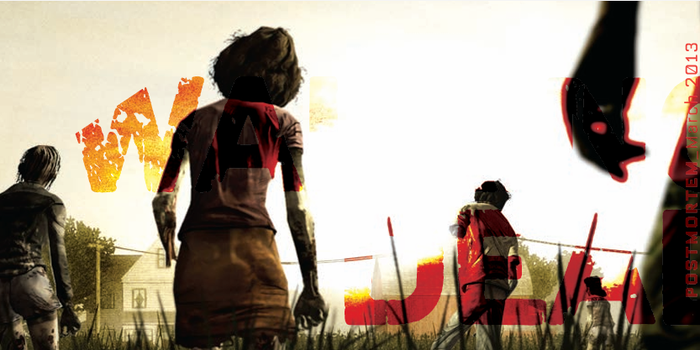
Image via Game Developer Magazine, March 2013.
Going in, we knew that in The Walking Dead you’d be confronted with awful choices, not much time to consider those choices, and then have to deal with the fallout of those choices. We did spend some time exploring integrating choice into more traditional game mechanics, but things didn’t start to really gel until we decided to go “all in” on choice. As a studio, we wholly embraced the idea that the game would allow narrative opportunities if they were plausible to the player. However, it wasn’t a simulation: We would still be handcrafting the “spine” of the story, and if a narrative option seemed plausible within that context, we committed ourselves to letting the player explore it.
A great example of this is a critical moment in the third episode. One member of your party, a woman named Lilly, suddenly and deliberately shoots another member of your party, ostensibly to ensure the ultimate safety of everyone. The initial idea for this section of the game was that zombies would then immediately drive the group back into their RV, which would force the player to deal with Lilly’s actions in those close, inescapable quarters. As the details of that interaction came into focus, it became clear how strongly we felt about the idea of abandoning her at that moment. This was a moment we simply had to allow the story to play out both ways (she stays or she goes). We felt that empowering the player in critical moments like this was far more satisfying than giving a blanket good or evil ranking.
We also discovered that smaller, more intimate details often worked much better for us than giant, sweeping, branching opportunities. For instance, it’s often more interesting to let the player slight or insult NPCs than it is to let the player outright steal all their belongings or completely betray them.
Sometimes there were great initial story ideas, but they included some plausible choices that didn’t lead to interesting places. For example, in episode two, we really wanted different characters (not just Mark) to end up as the St. Johns’ victim depending on how you played, but when we explored allowing him to play a more significant role, and even perhaps survive, he just wasn’t adding anything good to the story. He became a sort of vestigial story problem in an otherwise really good part of the game. In these cases, we had to punt. Often though, we would keep working until we had moments where all possibilities were compelling and producible. It was most exciting when we created moments where all possibilities felt equally compelling and intriguing. These made the choice taken and the choice not taken just as important to the player.
Other games have certainly explored choice and branching narrative before, though most of those games have used player choice as a subset of a larger gameplay mechanic. They typically had rather binary player choices such as good or evil, light side or dark side, etc. which in turn drove various AI and NPC systems. We felt strongly that a statistics-driven AI and NPC system would not be able to deliver the kind of experience we envisioned. Instead, our system tracks every choice a player makes at a very detailed level and then makes that information available to designers. They use that information to create narrative-driven logic that controls the content and subsequent choices that are offered to the player. Our version of choice isn’t emergent from a system, but a carefully crafted bespoke experience driven by narrative possibility. This is what we mean by “tailored narrative.”
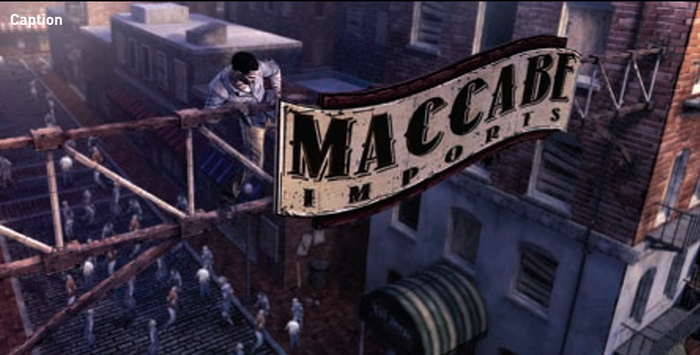
Image via Game Developer Magazine, March 2013.
Beginning with Jurassic Park we introduced the idea of individual episode directors. An episode director is akin to the film director of a movie. They work very closely with the writers, designers, and production departments to craft a vision of how the episode will unfold for the player. The director chooses the combination of narrative tools that are used to create each moment in the finished game. Their job is to leverage lighting, color, music, sound effects, composition, pacing, and contrast to make the best interactive experience they can, and then they have to communicate and drive that vision through to the completion of the episode. Having someone dedicated to interpreting the script and design of each episode in this way encourages everyone to approach their work from a narrative context first. It transforms everyone in the studio into a storyteller.
In this model, sound designers aren’t simply creating a room ambience anymore; they are contributing to a beat in a story in conjunction with their director. A modeler is creating environments for specific moments instead of generic simulations. Lighting setups change over the course of the episode based on narrative structure instead of the simple ticking of a clock. The artistic process isn’t driven by a simulation anymore, and instead serves the narrative context the player will experience.
The episode director isn’t a position at Telltale; it’s a role that is filled based on each episode’s unique circumstance, and a director needs to have passion for the license, the characters, the script, and the interactivity. We have opened this role to anyone in the studio, from any discipline, so long as they have a clear vision for what their episode will be, and the support and confidence of the team to execute it. So far, we’ve had directors come from writing, design, art, programming, and cinematics. (We haven’t yet had any directors from marketing or finance, but the door is open!)
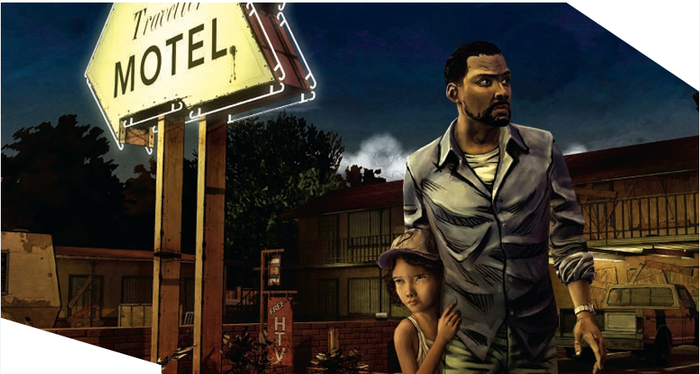
Image via Game Developer Magazine, March 2013.
There are deliberately no right or wrong choices in The Walking Dead. We didn’t set out to make a game you could win or lose. We wanted to expose difficult and interesting possibilities to players and reward them whatever they chose, while still leaving the choices not taken as a lingering possibility. The path not chosen should feel as important as the one they did choose. For instance, there is an opportunity to steal food from a stranger’s car in the second episode. Some might choose to steal the food in order to survive; others might view that as a loss of one’s humanity.
We wanted to enable the player to see where they stood compared to the rest of the world. So, at the end of each episode of The Walking Dead, we presented a statistics screen that shows five critical decisions the player made, and how their choices compared to other players. Exposing this to players transformed a single-player experience into a platform for social commentary, and encouraged players to discuss their motivations and experiences with each other. It also encouraged players to reconsider their choices and try replaying the episode from a different perspective. Although The Walking Dead isn’t a multiplayer game in the traditional sense, it certainly inspires a lot of conversations between friends and communities.
In addition to the five stats displayed at the end of each episode, the game also tracked dozens of other decisions players made. We were able to use this to help us understand what types of decisions were most interesting to players and reinforce those moments in subsequent episodes. In fact, at the end of episode four, we added an additional statistics screen showing what combination of survivors were joining you for episode five, and how your group compared to everyone else playing.
Creating a compelling narrative “possibility space” for a player is significantly more rewarding when players are able to see the bounds of that space and compare their place in that space with their family and friends.
Casting has always been tricky for us, and as we keep ratcheting up the drama in our games, the bar for our actors keeps rising as well. The Walking Dead had particularly tricky casting challenges. Our leading characters were a southern black professor and an eight-year-old girl, in addition to a large and diverse supporting cast. They certainly were not your typical video game fodder.
We had so many auditions that were more caricature than character. Of the actors who were able walk the line between too generic and overly stereotyped, there were few voices that matched the way we imagined our characters. Of the few actors left that we did like, many of them were unavailable, too far away, or over our budget.
We initially cast the voice of the main character, Lee, from this compromised field, and proceeded to record the first episode. When we got the first group of lines back, we knew we were in trouble. Lee just didn’t have the range and personality that the game demanded, and now we had a large production team waiting instead of implementing. We needed a new Lee, and fast.
Luckily, one of our cinematic artists suggested an actor he was a fan of: the eminently talented Dave Fennoy. We tracked him down, and he was able to quickly get us an audition. Once we heard him, we knew he was what we needed. Dave is not only a fantastic voice talent, but an amazing actor who created a Lee that was much more nuanced and dynamic than we had hoped. Dave gave us confidence and allowed us to push the character of Lee even further.
Clementine, the eight-year-old girl who is with you throughout the game, was also a casting challenge. She is not a precocious stereotyped kid, but a smart young lady who is desperately trying to make sense of a world turned upside down. Finding any adult actress to voice a young girl is challenging, but finding one that could portray a complex character like Clementine was especially difficult. We went through another arduous casting process before finding the amazing Melissa Hutchinson.
The Stranger, the ultimate villain at the end of the game, was also particularly difficult to cast. We needed the character to have a kind of quiet insanity. Once again, we cast and fully recorded what turned out to be the wrong actor. Literally the night before the schedule required we start recording, we found Anthony Lam—the creepy, quiet insane voice we were looking for. Fortunately, he was able to record immediately the following day. Those lines were being fed into the game as fast as they were recorded.
We need to get better at casting. As our games are becoming increasingly more sophisticated and dramatic, they are requiring more diverse and skilled actors. Fortunately, for The Walking Dead we were mostly able to find the great actors we required in time, but just barely.
The challenge of defining and communicating the essence of our characters in ways that provide talented actors the tools they need in a game context has proven to be a daunting and difficult task. Our actors rarely get to perform with one another—we usually record their parts individually—which makes it hard to offer them context or insights into their character’s motivation. Also, we’re finding that directing the performances during the actual recording sessions is itself a specialized skill set that we need to improve.
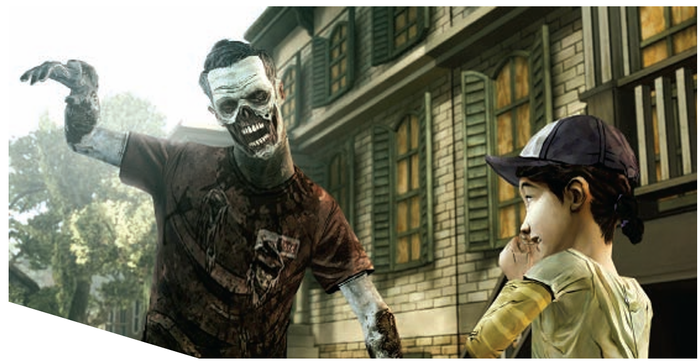
Image via Game Developer Magazine, March 2013.
While we were focusing intently on episode one, episode two was quietly coming to life in the background on its own.
When we went “all in” on choice, it changed how episode one became fun and engaging. As these things were changing, we were iterating at what seemed like light speed, tweaking interfaces and adding features like “choice notifications,” onscreen inventory, panic meters, and more. We were intensely critical of everything, and we were finding fantastic new ways to make choice compelling.
When we finally got episode one to a good place, episode two had already been written, recorded, and was partially into production. When we were able to compare episode one and two, they felt radically different. Episode one had all this really cool new stuff that wasn’t being exploited in episode two, and episode two felt kind of “old Telltale” by comparison. So we decided we just couldn’t move forward with the version of episode two we had.
We gathered a large group of writers, designers, producers, and directors offsite at a local hotel conference room and spent two days hammering out a new direction for the episode that exploited and even advanced everything that was feeling so great about episode one. Though some large elements such as locations, principal characters, and story beats remained, nearly all of the dialogue needed to be rewritten and then rerecorded. We were super enthused by the new design, but we were already behind schedule, leading to…
With a monthly episodic game company, the schedule is king and constantly looms over everything we do. Just imagine if you tuned in for the last episode of The Sopranos and there was a screen saying “Sorry, we didn’t get it done. Come back later!” All the recasting and retooling that happened early in the series took a lot more time than we had anticipated. By the time episode one really came together, our series launch date was upon us, and as they say, the show must go on! Episode one launched with a much better reception than we could have dreamed.
Unfortunately, now we were further behind schedule than we had ever been before. To make matters worse, we had a huge rewrite of episode two to complete before we could restart production on it. While the new episode two script was completed at breakneck speed and recorded as quickly as possible, we considered what could be done to get back on track. We ended up basically putting nearly everyone in the studio onto the project.
We have always been a multi-project studio, so we’ve never really had everyone working on the same game at the same time, and figuring out how to best divide production responsibilities among such a large group was tricky. We broke the action sections of the game (such as the zombie attacks) out into their own strike teams, while a different group owned the dialogue-driven parts. All in all, the studio quickly turned out some amazing content, but we were still weeks behind on episode two, and our schedule was still getting stretched out as far as it possibly could.
In the end, episode two ended up in customer’s hands nine weeks after episode one was released. Though this was an amazingly short time given the circumstances, customers were understandably anxious, and didn’t hesitate to let us know it. Our forums and Facebook pages were swarmed with people demanding their episode, and we didn’t do an adequate job of communicating what was happening.
By keeping the whole studio focused on The Walking Dead, we were able to make up most of the time. We wrapped the series just a few weeks short of its originally planned completion date.
The Walking Dead was our first game in which each episode was delivered as DLC instead of individual executables. This required a new “in-app” store, new content licensing code, and new download managers. That’s a lot of “new,” and furthermore, each platform had its own unique DLC quirks and complexities. iOS even required us to implement our own content delivery network! DLC also presented an entirely new QA process from simply staging content on partner networks, installing and uninstalling individual episodes, and controlling the licensing status of content on all our test accounts. We had a lot to learn about DLC.
In addition to DLC, the game was also the first to send telemetry back to the Telltale servers so we could present the choice statistics at the end of the episode. We created a new REST API specifically to handle this data, which required new code both on the web servers and in the game engine itself. Both of these changes were substantial, and they ended up being a lot of work to bite off with an important title like The Walking Dead, but we felt that the game would suffer significantly without these features.
When we launched, the game was incredibly well received, and our servers were quickly overwhelmed with the volume of hits they were receiving. When the servers stopped responding to the game, it would cause noticeable delays at the Press Start screen and at some save points during the episode. For the first few days, we actually ended up throwing incoming data away and serving a stock reply while we frantically brought more servers online.
On Xbox and PlayStation, the system handled the download of new episodes for us, but on iOS, the application also had to download the content for the user. This required a download manager, which turned out to have many more problems in the real world than we anticipated. Mobile devices tend to have significantly more network connection problems than PCs or consoles, and we just weren’t able to simulate the wide array of real-world circumstances we would encounter. Unfortunately this meant that too many iOS players had to suffer with us as we pored through our server logs, download code, and test cases to finally get the download manager as robust as it needed to be.
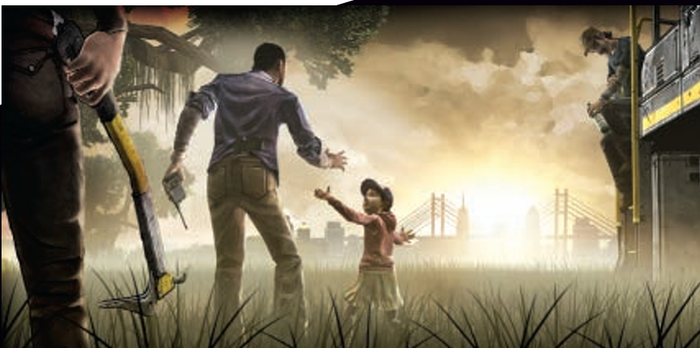
Image via Game Developer Magazine, March 2013.
Between the compressed schedule, the new DLC model, and the work required to launch on many platforms, we ended up with a lot of bugs.
The worst of these was related to our save game “rewind” system, which allowed the user to rewind the story an earlier point in the game. Since most of the episodes didn’t exist when the system was implemented, we didn’t have the test cases required to ferret out the edge cases that occurred in the real world. Unfortunately, that meant that some players lost their save data and had to replay the game from the beginning, which is about the worst thing that can happen to a player in a choicebased episodic game. Another bug caused the “generate random choices” dialogue to appear when in fact no random choices needed to be generated, which just made the players who were anxious about losing their save data even more worried.
In addition, each platform had its individual list of bugs, as well as the usual permutations of hardware-specific PC bugs, which made it very difficult for us to communicate solutions to the player. We found that many angry customers had to navigate a complex maze of information to find their solution. Even the best-intentioned users often ended up advising other users with solutions that worked in their context, but might be disastrous in another context. For example, some users would “tweak” their data to recover a save game, and other users might try a similar strategy, but end up destroying their save data. Obviously the root of the problem is the buggy system itself, as users should never have needed to attempt any of these things in the first place.
Though we’ve aggressively patched these issues and resolved most of them, you can’t really unring a bell. There are still small content bugs left in the game, and players are too often left with an impression that the game is buggy. All we can do at this point is continue to patch, and take what we’ve learned from this experience to ensure bugs like this don’t happen in the future.
For the last eight years, Telltale has been manically committed to the idea that interacting with characters and stories could be some of the best game experiences ever. We’re convinced that stories are not just for cutscenes—stories can be the game themselves. The Walking Dead is our example of the state of the art, but we’re confident that we can make playing a story even more compelling. We’ve also been equally committed to episodic games, smaller games, and cheaper games. And now we’ve built a studio that has matured to the point of being able to create a Game of the Year while staying true to these goals.
Fortunately for us, it looks like we’ll have an opportunity to continue exploring the space. Our game based on DC Comics’s Fables is well under way, The Walking Dead has a second season in the works, and many new properties are seeking out Telltale in hope of working with us to make a game. Stay tuned!
You May Also Like